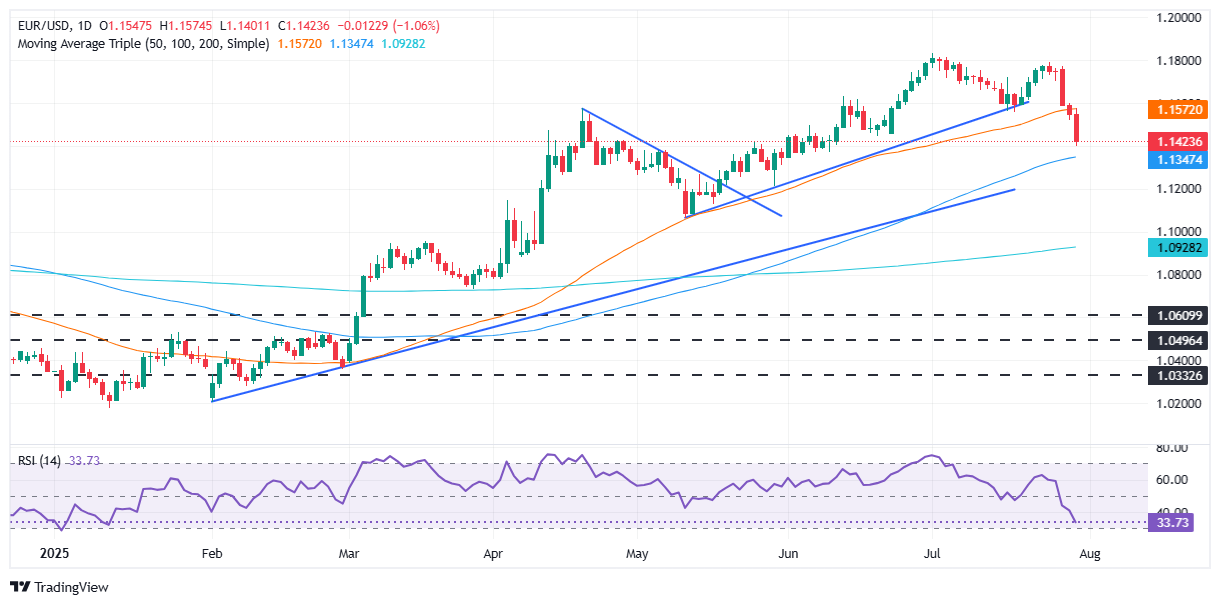- The Fed maintains stable rates, but Powell adopts a cautious and hard line tone about inflation and tariffs.
- The US GDP data and employment are surprised, reinforcing the Fed position of keeping high rates for longer.
- The weak growth of the Eurozone and a light calendar does not offer support, leaving the EUR/USD vulnerable to more falls.
The EUR/USD prolongs its losses for the third consecutive day, collapsing more than 1.20% while the Federal Reserve keeps the fees and Jerome Powell leans towards a hard line posture. In addition, the strong growth figures in the United States (USA) and a little economic calendar in the Eurozone pushed the torque below 1,1430, falling so far in the week more than 2.71%.
The shared currency extended its fall as the president of the FED, Powell, adopted a cautious position, without providing future guidance, with respect to the September meeting. He added that the uncertainty about the impact of tariffs on inflation establishes a higher threshold for Fed to reduce the fees.
Powell said that “the transfer of prices tariffs can be slower than thought.”
Previously, the Fed decided to maintain the federal fund rate in a range of 4.25%-4.50%at least until September, with a divided decision of 9-2, with governors Waller and Bowman in disagreement, opting for a rate cut of 0.25%rates.
The data in the US showed that the economy recovered strongly since the Gross Domestic Product (GDP) exceeded estimates. Previous data revealed that the labor market was strongly recovered, since private companies began to hire, after GU reports worse than expected in May and June.
Economic data in the EU revealed that the GDP of the block expanded 1.4% year -on -year in the second quarter of 2025, below the expansion of 1.5% in the first quarter. The GDP figures in Germany showed that the economy grew from 0% to 0.4% intertrimestral in the second quarter of 2025.
Retail sales of Germany for June increased an intermensual 1%, compared to a contraction of -1.6% in May, exceeding the forecasts of a growth of 0.5%.
The calendar for the rest of the week will include the underlying personal consumption expenses, the initial unemployment applications, the non -agricultural payroll figures (NFP) and the ISM manufacturing PMI.
Daily summary of market movements: EUR/USD falls through the US GDP, the Fed maintains
- The Federal Reserve’s monetary policy statement stressed that the growth of economic activity was moderated in the first half, although the unemployment rate remains low and inflation remains “somewhat high.”
- In addition, he added that the committee’s commitment is to achieve maximum employment and 2% inflation and acknowledged that “uncertainty about economic perspectives remains high.”
- The US economy was strongly recovered in the second quarter of 2025, with a GDP that increased an intertramestral 3.0%, exceeding the expectations of 2.4% and recovering from the contraction of -0.5% recorded in the first quarter, according to the Department of Commerce.
- Meanwhile, the National Employment Report of ADP showed that private sector payrolls increased by 104,000 in July, easily exceeding 78,000 and reversing the fall of 33,000 jobs in June.
- However, the housing market showed signs of voltage, since the sales of pending homes fell 0.8% intermensual in June, after an increase of 1.8% in May. The fall was greatly attributed to the high mortgage rates.
- Regarding the monetary policy of the ECB, Deutsche Bank does not expect more cuts and suggests that the next movement would be an increase in the late 2026.
Technical Perspectives: Bow trend of the EUR/USD Intacta, falls below 1,1500
The EUR/USD fell below 1,1500, extending its losses to 1,1400 near the single mobile (SMA) of 100 days of 1,1355. The relative force index (RSI) shows that sellers are in charge, after falling from around 40 to 34.60. This suggests that more falls are foreseen in the pair.
If the EUR/USD falls below 1,1400, the next test would be the 100 -day SMA and 1,1300. On the contrary, if the torque rises above 1,1500, the 50 -day SMA would be available in 1,1572.

EURO – FREQUENT QUESTIONS
The euro is the currency of the 19 countries of the European Union that belong to the Eurozone. It is the second most negotiated currency in the world, behind the US dollar. In 2022, it represented 31 % of all foreign exchange transactions, with an average daily business volume of more than 2.2 billion dollars a day. The EUR/USD is the most negotiated currency pair in the world, with an estimate of 30 %of all transactions, followed by the EUR/JPY (4 %), the EUR/GBP (3 %) and the EUR/AU (2 %).
The European Central Bank (ECB), based in Frankfurt (Germany), is the Eurozone reserve bank. The ECB establishes interest rates and manages monetary policy. The main mandate of the ECB is to maintain price stability, which means controlling inflation or stimulating growth. Its main tool is the rise or decrease in interest rates. Relatively high interest rates (or the expectation of higher types) usually benefit the euro and vice versa. The GOVERNMENT BOOK of the ECB makes decisions about monetary policy in meetings that are held eight times a year. The decisions are made by the directors of the National Banks of the Eurozone and six permanent members, including the president of the ECB, Christine Lagarde.
Eurozone inflation data, measured by the harmonized consumer prices index (IPCA), are an important economic indicator for the euro. If inflation increases more than expected, especially if it exceeds 2% of the ECB, it forces the ECB to rise interest rates to control it again. Relatively high interest rates compared to their counterparts usually benefit the euro, since they make the region more attractive as a place for global investors to deposit their money.
Published data measure the health of the economy and can have an impact on the euro. Indicators such as GDP, manufacturing and services PMIs, employment and consumer trust surveys can influence the direction of the single currency. A strong economy is good for the euro. Not only attracts more foreign investment, but it can encourage the ECB to raise interest rates, which will directly strengthen the euro. Otherwise, if economic data is weak, the euro is likely to fall. The economic data of the four largest economies in the euro zone (Germany, France, Italy and Spain) are especially significant, since they represent 75% of the economy of the euro area.
Another important fact that is published on the euro is the commercial balance. This indicator measures the difference between what a country earns with its exports and what you spend on imports during a given period. If a country produces highly demanded export products, its currency will gain value simply by the additional demand created by foreign buyers seeking to buy those goods. Therefore, a positive net trade balance strengthens a currency and vice versa in the case of a negative balance
Source: Fx Street
I am Joshua Winder, a senior-level journalist and editor at World Stock Market. I specialize in covering news related to the stock market and economic trends. With more than 8 years of experience in this field, I have become an expert in financial reporting.







